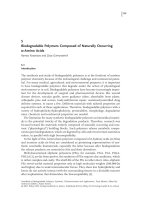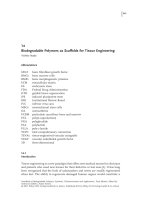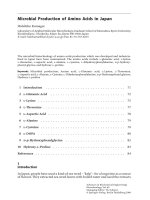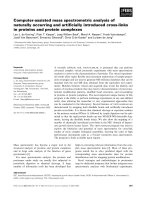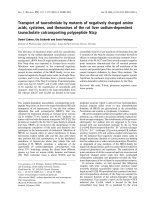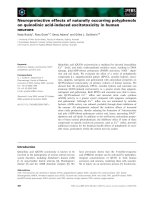Biodegradable Polymers Composed of Naturally Occurring α-Amino Acids
Bạn đang xem bản rút gọn của tài liệu. Xem và tải ngay bản đầy đủ của tài liệu tại đây (206.18 KB, 26 trang )
107
Biodegradable Polymers Composed of Naturally Occurring
α - Amino Acids
Ramaz Katsarava and Zaza Gomurashvili
5.1
Introduction
The synthesis and study of biodegradable polymers is at the forefront of modern
polymer chemistry because of the technological challenge and commercial poten-
tial. For many medical, agricultural, and environmental purposes, it is important
to have biodegradable polymers that degrade under the action of physiological
environment or in soil. Biodegradable polymers have become increasingly impor-
tant for the development of surgical and pharmaceutical devices like wound
closure devices, vascular grafts, nerve guidance tubes, absorbable bone plates,
orthopedic pins and screws, body - wall/hernia repair, sustained/controlled drug
delivery systems, to name a few. Different materials with tailored properties are
required for each of these applications. Therefore, biodegradable polymers with a
variety of hydrophilicity/hydrophobicity, permeability, morphology, degradation
rates, chemical, and mechanical properties are needed.
The limitation for many synthetic biodegradable polymers as biomedical materi-
als is the potential toxicity of the degradation products. Therefore, research was
focused toward the materials entirely composed of naturally occurring and non-
toxic ( “ physiological ” ) building blocks. Such polymers release metabolic compo-
nents upon biodegradation, which are digested by cells and reveal certain nutritious
values, in parallel with high biocompatibility.
In the light of this, heterochain polymers composed of α - hydroxy acid s ( α - HA s)
and α - amino acid s ( α - AA s) are considered as promising representatives of syn-
thetic resorbable biomaterials, especially the latter because after biodegradation
the release products are essential α - AAs and their derivatives.
Well - characterized aliphatic polyester s ( PE s), for example, PGA, PLA, PLGA,
PDLLA [1] , are far from perfect: the synthesis of PEs requires dry conditions, which
is rather complex and costly. The shelf - life of the PEs is rather short. Also, aliphatic
PEs reveal useful material properties only at high molecular weights (100,000 Da
and higher) due to weak intermolecular forces. They show low hydrophilicity and
hence do not actively interact with the surrounding tissues in a desirable manner
after implantation that diminishes the biocompatibility [2] .
Handbook of Biodegradable Polymers: Synthesis, Characterization and Applications, First Edition. Edited by
Andreas Lendlein, Adam Sisson.
© 2011 Wiley-VCH Verlag GmbH & Co. KGaA. Published 2011 by Wiley-VCH Verlag GmbH & Co. KGaA.
5
108
5 Biodegradable Polymers Composed of Naturally Occurring α-Amino Acids
On the other hand, α - AA - based polymers have strong hydrogen bonds due to
amide linkages that increase both intermolecular forces (that means desirable
material properties at much lower molecular weights) and hydrophilicity, and
hence biocompatibility [3] .
The earliest representatives of α - AAs based synthetic polymers were poly( α -
amino acids) (PAAs). The most common method for the synthesis of high - molec-
ular - weight PAAs is ring - opening polymerization of N - carboxyanhydrides. In spite
of expectations, PAAs that belong to the class of polyamides (Nylons - 2) and contain
only amide bonds in the backbones turned out to be less suitable as biodegradable
materials for biomedical engineering use for many reasons, such as diffi cult and
costly manufacturing processes because of unstable N - carboxyanhydrides, insolu-
bility in common organic solvents, thermal degradation on melting, and poor
processability. The rates of degradation under physiological conditions are often
too slow to be useful as biodegradable biomaterials. These limitations of PAAs
could be somewhat reduced by the synthesis of copolymers containing two or
more α - AAs. However, this originates immunogenicity, and the biodegradation
rate was still low due to the polyamide (PA) nature of the polymers [3] .
Therefore, the research efforts were redirected to the synthesis of α - AAs - based
polymers that contain easily cleavable (degradable) chemical bonds in the
backbones with molecular architecture that diminishes (or at all excludes)
immunogenicity.
How could macrochains using α - AAs as building blocks be constructed? Let us
consider the structure of α - AAs as a vector directed from N - terminus to C - terminus
(Figure 5.1 ).
Linear macrochains on the basis of α - AAs can be constructed using both α -
functional groups (H
2
N and COOH), or one α - (H
2
N or COOH) and one lateral
functional group F (which could be NH
2
, COOH, or OH). Hence, the orientation
of α - AAs in macrochains can be diverse (Figure 5.2 ).
This multifunctionality along with a high number of naturally occurring α - AAs
opens unlimited synthetic possibilities for constructing various macrochains.
Among the various possible orientations of α - AAs in the polymeric backbones,
the directional, “ head - to - tail ” orientation is conventional observed in biopolymers,
proteins, and polypeptides. This orientation determines their primary and second-
ary structures that, in turn, determine their biochemical properties including
immunogenicity. The same is true for synthetic poly - α - AAs [3] . All the said poly-
mers belong to the class of polypeptides, in fact AB type polyamides.
More promising for biomedical applications are synthetic polymers in which
the α - AAs have nonconventional orientations – adirectional ( “ head - to - head ” and
Figure 5.1
The general structure of α - AAs.
(α-C) (α-N)
H
2
NCH COOH
R
F
5.2 Amino Acid-Based Biodegradable Polymers (AABBPs)
109
“ tail - to - tail ” ), parallel, antiparallel, or mixed (Figure 5.2 ). These could be polymers
of other classes – polyurethanes and polyureas along with the said polyamides. To
render the polymers easily cleavable (in most cases hydrolysable), the labile chemi-
cal bonds have to be incorporated into the polymeric backbones to provide desir-
able rates of biodegradation. Preference should be given to ester bonds taking into
account both biodegradation rates and the stability (shelf life). The new polymers
comprising different types of heterolinks such as ester, urethane, urea, along with
peptide (amide) bonds, with the nonconventional orientation of α - AAs are expected
to diminish the immunogenicity of the polymers by “ confusing nature ” due to
“ unrecognizable ” structures of macromolecules.
5.2
Amino Acid - Based Biodegradable Polymers ( AABBP s)
5.2.1
Monomers for Synthesizing AABBP s
In this chapter, three classes of AABBPs containing ester bonds as biodegradable
sites are considered. These are AA - BB polycondensation polymers with noncon-
ventional “ head - to - head ” and “ tail - to - tail ” orientation of α - AAs in the polymeric
backbones – poly(ester amide) s ( PEA s), poly(ester urethane) s ( PEUR s), and
poly(ester urea) s ( PEU s). The PEAs are composed of three building blocks: (i) α -
AAs, (ii) fatty diols, and (iii) dicarboxylic acids. They allow manipulation of polymer
properties in a wide range. PEURs and PEUs are also composed of three types of
building blocks – two blocks are (i) α - AAs and (ii) diols; however, the third block
is (iii) carbonic acid.
5.2.1.1 Key Bis - Nucleophilic Monomers
Key monomers for synthesizing all three classes of AABBPs are bis - nucleophiles
that represent dimerized α - AAs - bis - ( α - amino acyl) - alkylene diester (tosic acid salt
of amino acid/alkylene diester, TAAD). These compounds are stable in the salt
form, commonly as di - p - toluenesulfonic acid (TosOH) salts. They are generally
Figure 5.2
The possible orientations of α - AAs in the polymeric backbones.
Directional:
Adirectional:
Parallel:
or
Antiparallel:
Mixed:
110
5 Biodegradable Polymers Composed of Naturally Occurring α-Amino Acids
prepared by direct condensation of α - AAs (2 mol) with fatty diols (1 mol) in
refl uxed benzene or toluene in the presence of TosOH monohydrate (2 mol),
Scheme 5.1 .
The presence of TosOH • H
2
O (2 mol) serves as both the reaction catalyst and
amino group protector, preventing undesirable side reactions including amine
interaction with inherent ester groups of TAAD.
This strategy allows us to generate diamine monomer with two inherent biode-
gradable (hydrolysable) ester bonds, along with enzyme specifi c groups, Figure
5.3 , and the nonconventional “ head - to - head ” orientation of α - AAs put at a
monomer stage.
The fi rst synthesis of TAAD according to this very simple procedure was reported
by Huang and coworkers [4] , on the basis of l - phenylalnine and 1,2 - ethanediol.
Later, TAADs were obtained from other hydrophibic α - amino acids: glycine [5 – 9] ,
alanine [10 – 13] , valine [14] , leucine [6, 14 – 21] , isoleucine, norleucine, methionine
[14] , phenylalanine [6, 7, 14 – 31] , and arginine [32 – 35] . Accordingly, arginine - based
TAADs are tetra - (TosOH) salts.
Scheme 5.1
Synthesis of TAADs.
TosOH
H
2
N CH(R) CO O
D
O CO CH(R)
NH
2
.
HOTos
.
-4 H
2
O
(TAAD)
2 H
2
N CH(R) COOH
HO
D
OH
2 TosOH H
2
O
.
++
or:
,
O
O
O
O
T
os
OH =
CH
3
SO
3
H
(CH
2
)
2
O (CH
2
)
2
(CH
2
)
2
O (CH
2
)
2
O (CH
2
)
2
(CH
2
)
2
O (CH
2
)
2
O (CH
2
)
2
O (CH
2
)
2
,
,
R is the lateral substituent of hydrophobic amino acids like: L-alanine (R=CH
3
), L-valine
(R=CH
2
C
6
H
5
), L and DL-methionine (R=(CH
2
)
2
SCH
3
), L-arginine (R=(CH
2
)
2
NHC(=NH)NH
2
).
D is divalent alkyl radical like (CH
2
)x with x = 2, 3, 4, 6, 8, 12;
(R=CH(CH
3
)
2
), L-leucine (R=CH
2
CH(CH
3
)
2
), L-isoleucine (R= CH(CH
3
)CH
2
CH
3
), L phenylalanine
Figure 5.3
Structural peculiarities of TAADs.
H
2
NCH
CO O
D
O CO CH
NH
2
R
R
Hydrolysable ester bonds
HOTos
.
TosOH
.
Enzyme
specific
groups
5.2 Amino Acid-Based Biodegradable Polymers (AABBPs)
111
Various aliphatic α , ω - alkylene diols [8 – 17, 21, 24, 27 – 35] , dianhydrohexitols [25,
26] , and di - , tri, and tetraethylene glycols [35, 36] were used by different authors
for synthesizing TAADs.
The obtained di - or tetra - TAADs are stable compounds. The most of these
monomers were purifi ed by recrystallizing from water or organic solvents. The
yields of pure, polycondensation grade products ranged within 60 – 90%.
5.2.1.2 Bis - Electrophiles
For successful synthesis of AABBPs with tailored architecture, the selection of
suitable bis - electrophilic monomer(s) is also important – counterpartners of
TAADs. The syntheses of various bis - electrophiles are discussed below as detailed
as possible within the bounds of this chapter.
Dicarboxylic acids HO – CO - A - CO – OH can be incorporated into the PEA back-
bones by means of either dichlorides Cl – CO - A - CO – Cl (dicarboxylic acid dichlo-
ride, DDC) or active diesters R
1
- CO - A - CO - R
1
(dicarboxylic acid active diester, DAD)
as bis - electrophilic monomers (for A and R
1
, see Scheme 5.2 ).
Many DDCs are commercial products. DADs are obtained using three synthetic
methods: (i) by interaction of DDCs with various hydroxyl compounds HOR
1
(activating agents), Scheme 5.2 [14, 15, 20, 24, 25] , or by direct interaction of
dicarboxylic acids (ii) with HOR
1
in the presence of various condensing (coupling)
agents, Figure 5.4 [15, 21, 37] , or (iii) with various trans - esterifying agents that are
derivatives of HOR
1
, Scheme 5.3 [37] .
All three methods give DADs in a good yield ranged from 60% to 90%.
Monomers for synthesizing PEURs. The third building block of PEURs – carbonic
acid – can be incorporated into the polymeric backbones by means of either bis -
chloroformates Cl – CO – O - D
1
- O – CO – Cl (diol bis - chloroformate, BCF) or active bis -
carbonates R
1
- CO – O - D
1
- O – CO - R
1
(DBCs) as bis - electrophilic monomers (D
1
can
be the same as D in Scheme 5.1 ).
Diol bis - carbonate s ( DBC s) can be obtained using two synthetic methods: (i) by
interaction of BCFs with hydroxyl compounds HOR
1
, Scheme 5.4 [38] , or (ii) by
interaction of diols with mono - chloroformates of hydroxyl compounds Cl – CO –
O - R
1
, Scheme 5.5 [39] .
The building block for PEUs, carbonic acid, can be incorporated into the poly-
meric backbones by means of polycondensation using either phosgene (deriva-
tives), or active carbonates ( AC ) obtained according to Scheme 5.6 or related
compounds [40] .
5.2.2
AABBP s ’ Synthesis Methods
PEAs. The synthesis of PEAs on the basis of TAADs can be carried out at a low
temperature via interfacial polycondensation ( IP ) and solution polycondensation
( SP ). The IP and SP reactions proceed according to Figure 5.5 in the presence of
acid acceptor (HCl and/or TosOH).
The selection of the polycondensation method depends on the nature of bis -
electrophilic monomer. The IP is suitable method when DDCs are used.
112
5 Biodegradable Polymers Composed of Naturally Occurring α-Amino Acids
Figure 5.4
Synthesis of DADs from free dicarboxylic acids using condensing agents,
method (ii).
HOOC A COOH
+ 2 HOR
1
Condensing agent, B
N
OC A CO O R
1
OR
1
Condensing agent = SOCl
2
, (CF
3
CO)
2
O,
CN
N C
6
H
11
C
6
H
11
B
N
= Tertiary amine (Pyridin, NEt
3,
etc.)
Scheme 5.2
Synthesis of DADs by interacting DDC with HOR1, method (i).
R
1
O CO
A CO O R
1
2 HOR
1
Cl CO A CO
Cl
+
NO
2
NO
2
NO
2
N
O
O
O
2
N
NO
2
O
2
N
Cl
Cl
Cl
Cl
Cl
Cl
Cl
Cl
F
F
F
F
F
etc.
R
1
=
A is divalent radical like:
(CH
2
)y with y = 2, 4, 8, 10, 12
α,ω
-Alkylenedicarboxylic acids
HOOC CH
2
O C (CH
2)y
COCH
2
COOH
O O
Bis-(succinic acid)-
α,ω
-alkylene diesters
HO C (CH
2
)
2
C O
D
O C (CH
2
)
2
C
O OO
OH
O
O,O'-Diacyl-bis-glycolic acids
trans(or cis)-Epoxy-succinic acid
Fumaric acid
CC
H
H
CC
H
H
O
Diglycolic acids
HOOC CH
2
OCH
2
COOH
1,3-Bis(4-carboxyphenoxy)propane
O (CH
2
)
3
O COOH
HOOC
However, this method results into high - molecular - weight PEAs only with the
hydrophobic diacids like sebacic acid with y = 8, or higher (Scheme 5.2 ) or
aromatic DDCs, such as terephthaloyl chloride [8 – 13] . It has to be noted that DDCs
are less suitable monomers for SP with aliphatic diamines since these electrophiles
enter into numerous undesirable side reactions with tertiary amines [41] that are
5.2 Amino Acid-Based Biodegradable Polymers (AABBPs)
113
Scheme 5.3
Synthesis of DADs from free dicarboxylic acids using trans - esterifying agents,
method (iii).
HOOC A COOH
(R
1
O)
3
P, B
N
(R
1
O)
2
CO,B
N
(R
1
O-CO-)
2
,B
N
OC A CO O R
1
OR
1
R
1
=
; B
N
= Tertiary amine (Pyridin, NEt
3,
etc.)
O
2
N
Scheme 5.4
Synthesis of DBCs by interacting BCFs with activating agents HOR1, method (i).
CO O
D
1
O CO ClCl
2 HOR
1
R
1
O CO
D
1
O
O CO OR
1
+
D
1
=
(CH
2
)
2
(CH
2
)
3
(CH
2
)
2
CHCH
3
(CH
2
)
2
O (CH
2
)
2
,
,,
etc.
or
R
1
=
N
O
O
O
2
N
Scheme 5.5
Synthesis of DBCs by interacting diols with p - nitrophenyl - chloroformate,
method (ii).
HO
D
1
OH
+
Cl CO
OR
1
2
with or without a tertiary amine
R
1
O CO
D
1
O
O CO OR
1
O
2
N
R
1
=
D
1
=
(CH
2
)
2
O (CH
2
)
2
(CH
2
)
2
O (CH
2
)
2
O (CH
2
)
2
,
,
(CH
2
)
2
O (CH
2
)
2
O (CH
2
)
2
O (CH
2
)
2
(CH
2
)
2
(CH
2
)
3
,
,
Scheme 5.6
Synthesis of active carbonates (AC).
Cl CO Cl
2 HOR
1
OCOO R
1
R
1
+
(AC)
O
2
N
, etc.
R
1
=
used as acceptors of liberated hydrogen chloride; for TAADs, tertiary amines are
used to remove TosOH from amino groups as well. These side reactions cause
the limitation of the chain growth resulting in the formation of low - molecular -
weight polymers with poor material properties.
For hydrolytically less stable DDCs, or DDCs that are unavailable at polycon-
densation purity (like short - chain succinic ( y = 2), adipic ( y = 4), fumaric, and
114
5 Biodegradable Polymers Composed of Naturally Occurring α-Amino Acids
epoxy - succinic acids, as well as bis - (succinic acid) - α , ω - alkylene diesters and O , O ′ -
diacyl - bis - glycolic acids, see Scheme 5.2 ), the preference should be given to SP
using DADs as bis - electrophilic monomers. The SP via active diesters of various
classes – DADs, DBCs, and ACs – is called “ active polycondensation ” ( AP ) [42] to
distinguish it from traditional polycondensation methods. Hereafter we use the
term AP for polycondensation with participating active diester of diacid. The AP
with DADs is normally carried out in polar aprotic solvents DMA, DMSO, etc., or
in common organic solvents like chloroform, THF, etc., at 20 – 80 ° C using mostly
triethylamine ( TEA ) as TosOH acceptor [14 – 16, 20 – 22, 24, 25, 27, 28, 32, 33, 42 –
47] . It was shown that DADs are stable against both amide - type solvents and terti-
ary amines [48] under the conditions of AP that minimizes undesirable side
reactions and results in the formation of high - molecular - weight polymers.
It has to be noted that PEAs composed of the same three building blocks – α - AA
(glycine), fatty diols, and dicarboxylic acids – were synthesized recently [5] using
the third method – thermal polycondensation ( TP ) in melt, in the presence of
titanium butoxyde as a catalyst at 160 – 220 ° C.
The advantage of TP is the possibility to process polymers from melt directly
after the polycondensation, that is, without the separation and purifi cation of the
resulting polymers. However, the method is less suitable for thermally sensitive
and unstable monomers including optically active ones since high reaction tem-
perature can cause racemization and destruction. The use of metalorganic catalyst
is one of the drawbacks as well.
The AABBPs type PEURs can be synthesized on the basis of TAADs under the
conditions of either IP or AP similar to Figure 5.5 using as bis - electrophilic mono-
mers BCFs instead of DDCs, and DBCs instead of DADs.
Like for the PEA, the PEUR synthesis by IP is less suitable with short - chain
DBC due to their hydrolytic instability that results in low - molecular - weight poly-
mers. Kohn et al. [49 – 51] suggest that more appropriate monomers for poly-
urethane synthesis via IP are DBCs that are hydrolytically more stable. The results
Figure 5.5
Synthesis of PEAs by IP and SP (AP).
TosOH
H
2
N CH(R)
CO O
D
O CO CH(R) NH
2
.
HOTos
.
n
Cl CO A CO Cl
n
CO
ACO
O
n
R
1
OR
1
HN CH(R) CO O
D
O CO CH(R)
NH
CO A CO
n
PEAs
+
or
pTSA and HCl acceptor
5.2 Amino Acid-Based Biodegradable Polymers (AABBPs)
115
are high - molecular - weight lysine based poly(ether urethane)s even on the basis of
water - soluble monomers – bis - succinimidyl carbonates of PEGs (PEG - based
DBCs). The same approach seems promising for the synthesis of PEURs on the
basis of TAADs.
DBCs were very effective as bis - electrophiles in AP as well. They resulted in the
high - molecular - weight PEURs [16, 52] having excellent fi lm - forming properties.
The conditions of AP with DBCs are the same as for DADs above.
The PEUs on the basis of TAADs can also be synthesized via IP or AP similar
to Figure 5.5 using phosgenes (mono, di, or tri) as bis - electrophilic monomers
instead of DDCs [53] , and ACs instead of DADs [52] . In contrast to PEAs and
PEURs above, IP unambiguously led to high - molecular - weight PEUs.
5.2.3
AABBP s: Synthesis, Structure, and Transformations
5.2.3.1 Poly(ester amide)s
Regular PEAs . We consider as “ nonfunctional ” those PEAs that have no functional
groups except two terminal reactive groups – normally one nucleohpile and one
electrophile, Figure 5.6 .
According to the polycondensation theory of Kricheldorf [54, 55] , a substantial
portion of macromolecules obtained via AP have no terminal functional groups,
since they form macrocycles.
The fi rst “ nonfunctional ” regular PEAs representing AABBPs [6, 7, 14, 17, 18,
24 – 26] was synthesized via AP of TAADs with active diesters of α , ω -
alkylenedicarboxylic acids [A = (CH
2
) y ], according to Figure 5.5 above.
Polysuccinates . Recently [44] a new class of nonfunctional AABBPs – PEAs based
on succinic acid (rather alkylene disuccinates) with higher density of cleavable
ester bonds – were synthesized by AP of TAADs with active di - p - nitrophenyl esters
of bis - (succinic acid) - α , ω - alkylene diesters (Scheme 5.2 ). Their general structure
is given in Figure 5.7 .
Polysuccinates have two additional ester bonds (in total four ester bonds) as
compared with regular PEAs above, having in total two ester bonds per repeating
Figure 5.6
Regular PEAs composed of α - AAs, diols and α , ω - alkylenedicarboxylic acids.
HO CO (CH
2
)y CO NH CH
R
CO O D
O CO CH
R
NH
H
n
Figure 5.7
PEAs on the basis of bis - (succinic acid) - α , ω - alkylene diesters.
CH
R
C
O
O
D
O C
O
CH NH
R
O C
O
(CH
2
)
2
C
O
O D O C
O
(CH
2
)
2
C
O
NH
n
R = CH
2
CH(CH
3
)
2
, CH
2
C
6
H
5
; D = (CH
2
)
4
, (CH
2
)
6
, (CH
2
)
8
116
5 Biodegradable Polymers Composed of Naturally Occurring α-Amino Acids
unit, and showed increased biodegradation rates. Additionally, the enhanced
hydrolysis of polysuccinates is linked with intramolecular catalysis (see Ref. [56]
and references cited therein).
Poly(depsipeptide)s (PDPs) . Very recently [21, 43] a new class of nonfunctional
AABBPs – AA - BB - type PDPs – were obtained by AP of TAADs with active di - p - ni-
trophenyl esters of O , O ′ - diacyl - bis - glycolic acids (Scheme 5.2 ) and have the general
structure given in Figure 5.8 .
PDPs also have two additional and highly polarized (close by nature to the ester
bonds in poly(glycolic acid)) ester bonds (in total four ester bonds) as compared
with regular PEAs above, containing two ester bonds per elemental links, and
hence showed increased biodegradation rates.
Functional PEAs. Polyacids. Katsarava and Chu [15, 16] synthesized functional
co - PEAs containing a variable amount of lateral carboxyl groups, applying di -
TosOH salt of l - lysine benzyl ester as a comonomer. The goal co - PEAs were
obtained by selective catalytic hydrogenolysis (debenzylation) of benzyl ester pre-
polymer using Pd catalyst. Free lateral COOH groups can be used for numerous
chemical transformations and co - PEAs are suitable drug carriers that will be dis-
cussed below. It has to be noted that lysine has parallel orientation (Figure 5.2 ),
whereas other amino acids ’ orientation is adirectional, that is, in whole α - AAs ’
orientation in this types of polymers is mixed.
Polycations. Arginine - based TAADs are tetra - TosOH salts that act as bifunctional
nucleophilic monomer (via two α - amino groups). This allows to synthesize the
linear and soluble polycationic PEAs (Figure 5.9 ) by AP of l - arginine - based TAADs
with di - p - nitrophenyl esters of α , ω - alkylenedicarboxylic acids [33 – 35] .
The arginine - based PEA composed of succinic acid and 1,3 - propanediol (the less
hydrophobic one among the PEAs obtained) was water soluble at room tempera-
ture. Very recently Memanishvili et al. [35] obtained arginine - based poly(ether ester
amide)s, PEEAs, and poly(ether ester urethane)s, PEEURs, and poly(ether ester
Figure 5.8
AA - BB PDPs composed of glycolic acid, α - AAs, and dicarboxylic acids.
n
C CH
2
OC(CH
2
)y C O CH
2
C
O
O
O O
HN CH CO
D
O C CH
RR
NH
O
O
R = CH
2
CH(CH
3
)
2
, CH
2
C
6
H
5
; D = (CH
2
)
8
, (CH
2
)
12
; y = 4, 8.
Figure 5.9
Arginine - based cationic ABBPs - PEAs.
CO (CH
2
)y CO NH CH CO
OD
O CO CH NH
n
NH
C
HN
NH
2
NH
C
TosOH
HOsoT
H
2
N
NH
.
.
y = 2, 4, 8; D = (CH
2
)
3
, (CH
2
)
4
, (CH
2
)
6

